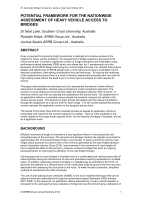Bridges

Potential Framework for the Nationwide Assessment of Heavy Vehicle Access to Bridges
- Publication no: ABC-AAI205-14
- Published: 22 October 2014
- PDF (free) Download
A key component to improving freight productivity in Australia is to improve access to the network for heavy vehicle operators. The assessment of bridge capacity is perceived to be critical to this aim. Currently a significant number of bridge evaluations are undertaken using performance-based standards (PBS) which only allows fast, tier 1 assessments up to the equivalent of the MS18 design load using the current bridge formulae. For vehicles that produce greater load effects than an MS18 design load, a more rigorous process is undertaken by the relevant jurisdictions, often taking considerable time and resources. To improve the timeliness of the assessment process there is a need to develop assessment processes that can cater for high loading levels without the need to go to a more rigorous analysis for every request for access.This paper demonstrates the development of an assessment framework to allow fast assessment of application vehicles using a simple line model comparison approach. The process involves setting service levels that reflect the historic bridge design levels adopted to design bridges. A reference vehicle can then be selected and calibrated to the service level. The assessment of an application vehicle is conducted using a simple line model to compare the vehicle to the various service levels. The actual access decision still resides with the relevant jurisdiction through the assignment of a service level to each bridge. The line model assessment process merely evaluates the application vehicle to the relevant service level. The results of the study show that the proposed process to assess an application vehicle is reasonable with respect to the moment capacity of a bridge. There is more variability in the results related to the bridge shear capacity which, for the majority of bridges in Australia, will not be a significant issue.
Related publications
WEB-R703-24
Latest Bridges News
